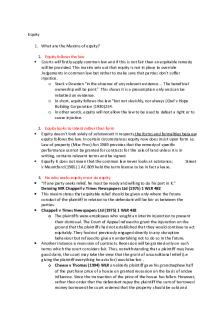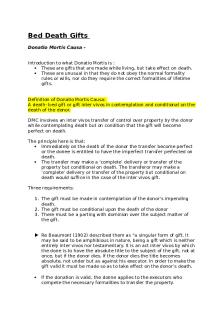Muscular System Part 5 - important key notes for exams PDF

| Title | Muscular System Part 5 - important key notes for exams |
|---|---|
| Author | Natalia Weitzel |
| Course | Basic Anatomy & Physiology I |
| Institution | Camden County College |
| Pages | 3 |
| File Size | 76.6 KB |
| File Type | |
| Total Downloads | 58 |
| Total Views | 151 |
Summary
important key notes for exams...
Description
Muscular System Part 5 Chapter 10
● ●
Origin = NO movement Insertion = movement ○ Ex: biceps brachii muscle - origins (shoulder region), insertion (radius)
Muscle Movements -Functional Groups: 1. Prime mover/Agonist ○ Ex: pectoralis major – total arm flexion* ○ Ex: biceps brachii – forearm flexion* 2. Antagonists - (muscles that oppose agonist movement); **can also be considered prime movers* ○ Ex: latissimus dorsi – antagonist to pectoralis major ○ Ex: triceps brachii – antagonist to biceps brachii 3. Synergists – assisting movements/supportive; **also stabilize joints (undesirable movements)** ○ Ex: finger flexors ○ Subcategory: "Fixators" - a synergist that specifically immobilizes a bone ■ Ex: scapula ■ Ex: muscles of posture 4.
7 Criteria for Naming Skeletal Muscles 1. Location of muscle – ○ Ex: temporalis, intercostals, rectus, abdominis 2. Shape of muscle – ○ Ex: Deltoid = "delta" shape ○ Trapezius = trapezoid shape 3. Size of muscle - maximus, minimus, longus, brevis, gluteus maximus
4. Direction of fibers - Rectus, transversus (horizontal), oblique ○ Ex: rectus femoris 5. Number of origins – name lists number of origins*** ○ Ex: BIceps brachii = 2 origins ○ Ex: TRIceps brachii = 3 origins ○ QUADriceps = 4 origins 6. Location of origins and insertions ○ Ex: sternocleidomastoid: insertion = mastoid process; origins = sternum & clavicle 7. Action of muscle – flexor, adductor, extensor ○ Ex: "adductor longus"
Fascicle Arrangement **determine muscle's force and shape*** -Patterns of Fascicle Arrangement: 1. Circular – muscles that surround body openings ("sphincters") 1. Ex: mouth - "orbicularis oris" 2. *** origins around outside of circle insertions on inside of circle*** 2. Convergent – fascicles converge toward insertion; triangular fan shaped muscles 1. Ex: pectoralis major deltoid 3. Parallel – fascicles & fibers run parallel to muscle axis 1. Ex: strap or spindle shape muscles 2. Ex: biceps brachii (spindle shape) 4. Pennate – fascicles are short & fan shaped converging to central tendon of muscle 1. Unipennate: fascicles insert into one side of tendon ■ Ex: extensor digitorum 2. Bipennate: fascicles into both sides of muscle's central tendon (feather) ■ Ex: rectus femoris 3. Multipennate: fascicles arranged around small tendons inserting into one larger central tendon (many feathers) ■ Ex: deltoid ***Arrangement of fascicles determines its range of motion & power*** ***Muscles with parallel fascicles shorten most, but these are NOT most powerful***
***Muscle's power determined by the number of fibers in fascicles/muscle***
Muscles & Levers ●
Lever (bone) – rigid bar moves on a fulcrum (a.k.a. fixed point) (joints); "load" bone itself ○ Power Lever: strong; load is near fulcrum (NOT much movement) ○ Speed Lever: weak; load is far from fulcrum; fast (MUCH movement)
-Class of Levers1. 1st Class: ***mechanical*** 2. 2nd class: ***advantage; slower; more stable*** 3. 3rd Class: **MOST skeletal muscles of body behave as 3rd class***; mechanical disadvantage; not strong but very fast; ***muscles tend to be thicker around these levers*** ○ Ex: hinge joints...
Similar Free PDFs

Important notes for ch 5
- 2 Pages

Muscular system - Lecture notes
- 27 Pages

CRPC Notes for Exams
- 117 Pages

Coownership Notes FOR Exams
- 16 Pages

Chapter 8 Muscular System
- 3 Pages

Muscular System and Miology
- 2 Pages

Chapter 7 Muscular System
- 15 Pages

BTEC Revision Muscular System
- 18 Pages

Script anatomy Muscular system
- 79 Pages
Popular Institutions
- Tinajero National High School - Annex
- Politeknik Caltex Riau
- Yokohama City University
- SGT University
- University of Al-Qadisiyah
- Divine Word College of Vigan
- Techniek College Rotterdam
- Universidade de Santiago
- Universiti Teknologi MARA Cawangan Johor Kampus Pasir Gudang
- Poltekkes Kemenkes Yogyakarta
- Baguio City National High School
- Colegio san marcos
- preparatoria uno
- Centro de Bachillerato Tecnológico Industrial y de Servicios No. 107
- Dalian Maritime University
- Quang Trung Secondary School
- Colegio Tecnológico en Informática
- Corporación Regional de Educación Superior
- Grupo CEDVA
- Dar Al Uloom University
- Centro de Estudios Preuniversitarios de la Universidad Nacional de Ingeniería
- 上智大学
- Aakash International School, Nuna Majara
- San Felipe Neri Catholic School
- Kang Chiao International School - New Taipei City
- Misamis Occidental National High School
- Institución Educativa Escuela Normal Juan Ladrilleros
- Kolehiyo ng Pantukan
- Batanes State College
- Instituto Continental
- Sekolah Menengah Kejuruan Kesehatan Kaltara (Tarakan)
- Colegio de La Inmaculada Concepcion - Cebu






